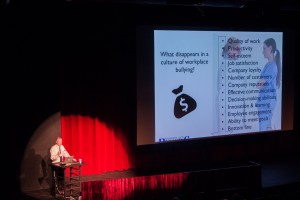
Bullies in the workplace are an “American cancer,” according to Richard P. Himmer in his BYU Education Week presentation on Monday.
Himmer focused his comments on bully leaders. Workplace bullying is often denied by and perpetuated by incompetent leaders who lack emotional intelligence, he said. His research shows that 56 percent of workplace bullying comes from bully bosses.
Himmer defined workplace bullying as psychological violence. It comes in the form of intimidating, threatening or humiliating behavior and can involve withholding critical information from coworkers or employes. Himmer said in order to be classified as bullying, such behavior is repeated over a period of at least six months.
The result of such behavior on witnesses, targets, and the company overall are varied, but all negative.
Often, employees who do not trust their leaders only produce the bare minimum effort required to retain their employment. It also leads to greater absenteeism, turnover, vengeful behaviors and customer complaints.
Witnesses often are just as affected. Twenty-one percent of employees have been indirectly impacted by bullying and will spend 52 percent of their time avoiding the bully.
That turnover often costs the company greatly in the long run. Himmer said the cost of replacing an employee as 1.5 to 2.5 times the salary of the employee being replaced. In a company of 50 employees with one bully leader, Himmer said about eight will leave the company as a result of bullying. This will cost the company $825,000 a year, assuming the average annual salary is $50,000.
But targets suffer the worst of a bully’s actions.
Physical ailments resulting from bullying include several cardiovascular issues such as cardiac failure, stroke and coronary heart failure, and other issues such as irritable bowel syndrome, chronic fatigue, fibromyalgia, skin disorders and ischemia (restriction of blood to a body part). Psychological impacts include PTSD, depression, anger and anxiety—behaviors that are sometimes violent and retributive.
“Work trauma, according to researchers, is as severely emotionally damaging as rape,” Himmer read from a slide in his presentation.
He also claimed that nearly all “postal” shooting stories, or workplace shooting rampages, that he has studied included at least one instance of severe workplace bullying.
Targets often face a double whammy when they take their bullying problems to other leaders.
Because most bullying comes from incompetent bosses either bullying workers themselves or allowing bullying to happen, targets rarely see justice. Himmer said that 72 percent of the time, employers react in a way that is not helpful to the target. Twenty-five percent of reactions are a denial that the bullying is happening. Only 12 percent of reactions lead to the elimination of bullying and 28 percent are either condemning, acknowledging or eliminating the complaint.
Further, studies as recently as 2009 show near unanimity among surveyed company leaders saying that workplace bullying did not exist. Previous studies show people generally knew little to nothing about workplace bullying.
Himmer cautioned strongly against solutions that involve putting the target and the bully in a face-to-face confrontation. He said bullies are skilled in projecting, or making the victim out to be doing the bullying behavior. Cultural and leadership policies that are perpetuated from the top down are often the best way to eliminate the acceptance of bullying.




